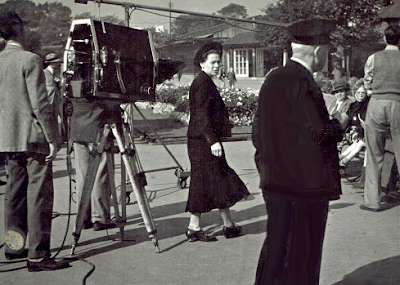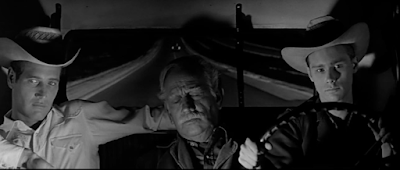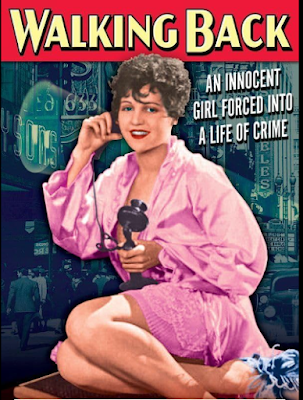When people ask me
what’s the difference between watching a nitrate print and another… I commonly
use the analogy of a photocopy of a picture compared to a stain glass
window…
Bryony Dixon was describing
the nature of nitrate on this day in which we would see four films which,
literally showed us more on screen. There is more luminosity and translucence with
nitrate film and greater depth and clarity; you can see details in the
velvet-black it doesn’t have the block-blacks you can get with even the highest
quality digital and celluloid.
Nothing in this
fantastic festival of film on actual film comes easy and the love that dares to
speak the name nitrate was in full effect as the programme director
James Bell, BFI’s Senior Curator of Fiction, lined up on stage with colleagues
to explain the process of selecting, testing and projecting those that have made
the cut to be shown in the only UK cinema capable of screening nitrate – a projection
box made out of Durasteel – asbestos sandwiched between two sheets of steel in
1953.
The BFI hold some 44,000
films on nitrate stock but as Sonia Genaitay, Curatorial Archivist pointed out,
not all are in screen able condition. Age withers and curls nitrate and finding
films that can be projected is a detailed progress involving testing and eyeballing
with Dominic Simmons, Head of Technical, providing the ultimate
projector-accepted testing of the films we were to watch. Some 50 titles were
considered this year with just five making the cut.
James said that
they hoped to screen more nitrate throughout the year and we can only be
thankful for the efforts made to preserve and present these special shows.
Talking of which, a tip of the hat to today’s projectionists: Mark Kennedy,
Mick Fife and Lauren Feyderline without whom we’d be staring into space.
 |
| The BFI team explain the wonders of nitrate |
Un Chien
Andalou (1928), 35mm nitrate
"NOTHING,
in the film, SYMBOLIZES ANYTHING. The only method of investigation of the
symbols would be, perhaps, psychoanalysis."
It was only just
lunchtime when DJ Christopher Bird hit the decks in NFT 1 to replicate the
original accompaniment to Dali and Bunel’s 1929 surrealist masterwork, An
Andalusian Dog (Un Chien Andalou) a film they were determined would
not mean anything although as Breton’s Exquisite Cadaver exercise had proven,
everything has some meaning even and especially unintentionally. Luis Buñuel
intended to “mash up” – as The Kids now say – Argentinian Tango music with
Wagner and all but invented Classical Lounge Core without knowing it and Chris was
tasked with cutting from one to the other by playing contemporary pressings on
two 78 rpm turntables, one of which was a top of the range EMG machine from
1932 which produced remarkable clarity and range.
Introducing, Bryony said that the first surrealist film was founded on two dreams that Dali and Bunel had had with the condition that no idea or image that might lend itself to a rational explanation of any kind would be accepted… and so it proves with Dali’s ideas and ants (finally sourced from Spanish mountains after a fruitless and ant-less search of Paris by taxi) masterfully expressed by Bunel. Pierre Batcheff, who I now recognise from other French silent films, and Simone Mareuil add their own levels of un-meaning amongst the “situations” and as per usual, I still don’t know how the eye-cutting scene was done, not that I can look at it.
This could have
been the fragile prints final projection and the accompaniment from DJ Bird
made for a fitting last hurrah!
 |
| Spanish ants on Pierre Batcheff's hand as Simone Mareuil looks on. |
Partie de
campagne (1936), 35mm nitrate
Backgrounds are
as important as foregrounds. Flowers, faces and mountains are not just placed
side by side. They constitute a collection of elements all rolled into one,
amalgamated by a love stronger than their differences. Jean discussing his
father Auguste Renoir.
Jean Renoir seems
to have been fascinated by waterways and, in addition to The River
(1951), he also directed his first feature, La Fille de l’eau (1925),
just a few kilometres away in Marlotte from Partie’s location on the
banks of the Loing and the Essonne rivers, left tributaries of the Seine some
way out from Paris. The river is life, it is unpredictable and yet it can rush
us to our destiny whilst the trees at the water’s edge can bind lovers together
but they can also hide and confuse. As much as the river is ever present, it
keeps on moving the narrative and characters’ choices can be lost in the
swirling momentum.
Partie de
campagne is based on a short story by French “realist” Guy de
Maupassant (author of Bel-Ami (1885) and Pierre et Jean (1888)) published
in 1881 (set in 1860 during the reign of Emperor Napoleon III) and offering a shock
of bitter fate amongst the bucolic dreaminess.
Parisian hardware
store owner, Dufour (André Gabriello) takes his wife (Jane Marken) and daughter
Henriette (Sylvia Bataille) along with his dishevelled clerk, Anatole (Paul
Temps) into the countryside where they stop at an inn run by a manager played
by Jean Renoir. Two young men, Henri (Georges d’Arnoux) and Rodolphe (Jacques
Brunius), are bewitched watching Henriette and her mother (Jane Marken) on the
swings and resolve to try their luck. All innocent fun but things get rather
more serious when the two couples head out on the water… just a simple day in
the country, what could be less innocuous?
 |
| Sylvia Bataille and Georges d’Arnoux |
Blanche Fury
(1947), 35mm nitrate
English
melodrama done with same sort of conviction that Bette Davis and Joan Crawford
brings to their films…
Jympson Harmon,
London Evening News 19th Feb ‘48
Now it was time for
British technicolour nitrate on and Valerie Hobson in all her auburn glory
alongside the moodiest Stewart Granger for whom we needed all the depth and
visual subtlety of nitrate to see the shadows within. He reminded me a Paul
Newman in yesterday’s Hud, a man so obsessed by the perceived wrong done
to him by careless parents, that he couldn’t see a way out. This was a Brit
gothic romance almost without the romance but with vengeance at its heart, a
very dark film for 1947 but then it had been a very dark time. Amongst the velvety
shadows we were afforded glorious views of Miss Hobson’s costumery, designed by
Sophie Harris from theatrical costumers Motley and as the story darkens so too
do the textures change colour as the reds and darker hues of passion replace
her earlier calculations and manners.
Jo Botting, the
BFI’s Curator of Fiction, introduced and gave a flavour of the impact of the
still relatively rare Technicolor. Miss Hobson’s pale skin and auburn hair benefited
from the process being especially striking in the daylight whilst the Daily
Mirror reviewer probably watched a late showing after closing time… “the
colour camera seems to be kinder to Valerie Hobson than most other actors, she
always looks good in black and white film but in colour what a smasher!”
Won’t disagree with
that and Mr Grainger looks well too as French director, Marc Allégret respects
the material and creates and engaging psycho drama that, with standard generic
tropes still persuades through the elegance of composition and force of
performance. It makes Saraband for Dead Lovers (1948) look drab and tame
in comparison.
Jo quoted the Mirror again: Emphatically a woman’s picture… for every man who scuttles off to the nearest bar at least five women will remain to revel in someone else’s unhappy and illicit love story! Not a single fellow left for the bar, well, not until the film was over to thunderous applause. We were lost in mid-Victorian reveries in the layered gloom.
 |
| Valerie Hobson abides... |
The Man Who
Knew Too Much (1934), 35mm nitrate
The Man Who Knew
Too Much (1934) may have been the film that established the talkie Alfred
Hitchcock but after a largely witty and energetic start it descended into an
extended shoot out with its easy-going capers replaced by a rising body count
of police and Germanic rebels with an unknown cause: almost The Film That Slew
Too Much? Still, there was no Doris Day to sing Que Sera Sera as in
the 1956 remake and absolutely a smaller budget along with some excellent
performances especially from Leslie Banks and a deeply disturbing Peter Lorre,
hooded eyes accentuated by a dyed streak in his hair and his tendency to laugh
in the face of anything: jokes, murder, infanticide and certain death.
Hitchcock told François
Truffaut that "… the first version is the work of a talented amateur and
the second was made by a professional." I’m not entirely buying that,
especially as this was his 20th feature film and clearly has some of
the hallmarks of his most engaging work – an “invasion” of normal family life
by lethal forces, witty dialogue from leading characters unaware of the threat
at hand and an almost likeable villain… In the midst of life, we are in death
or, in this case, the midst of a dinner dance as a man is shot and passes on a
key message on which the rest of the film’s story will rest.
 |
| Peter Lorre, Leslie Banks and Nova Pilbeam |
The Lawrences Bob
(Leslie Banks) and Jill (Edna Best) are on a holiday in Switzerland with their
daughter Betty (Nova Pilbeam) and their dog (actor unknown). Jill loses a clay
pigeon shooting contest thanks to her impatient Betty with the Germanic Ramon (Frank
Vosper) gracious – and suspicious in victory. At the dance that evening their French
friend Louis (Pierre Fresnay) – a skier with whom Edna flirts unrelentingly –
is shot dead but manages to pass on a note to be passed onto the British Consulate…
The couple read the details, it’s a warning of an international crime about to
be committed but before they can do anything, Betty is kidnapped and they are
under strict instructions not to say anything to anyone.
A classic Hitchcock
set up with ordinary – wealthy middle class – heroes stuck between the good and
bad guys, in this case led by the aforementioned grinning Abbott (Peter Lorre).
Events move at some lick until the aforementioned final sequence involving the
Royal Albert Hall, a hide-out at a sun-worshipping church (?!) and a mass shoot
out. It’s Hitch 22 as the Lawrences must not let on what they know even as they
must find out more to save their daughter.
So ended another breathless day on the Southbank and it
was not just our imaginations that received these films in a deeper way than
usual, we literally saw more, but by no means “too much”!
Thank you BFI and… till the next time!
 |
| Christopher Bird at the EMG gramophone (picture from Lynne
Wake) |


































%20Despair.png)








